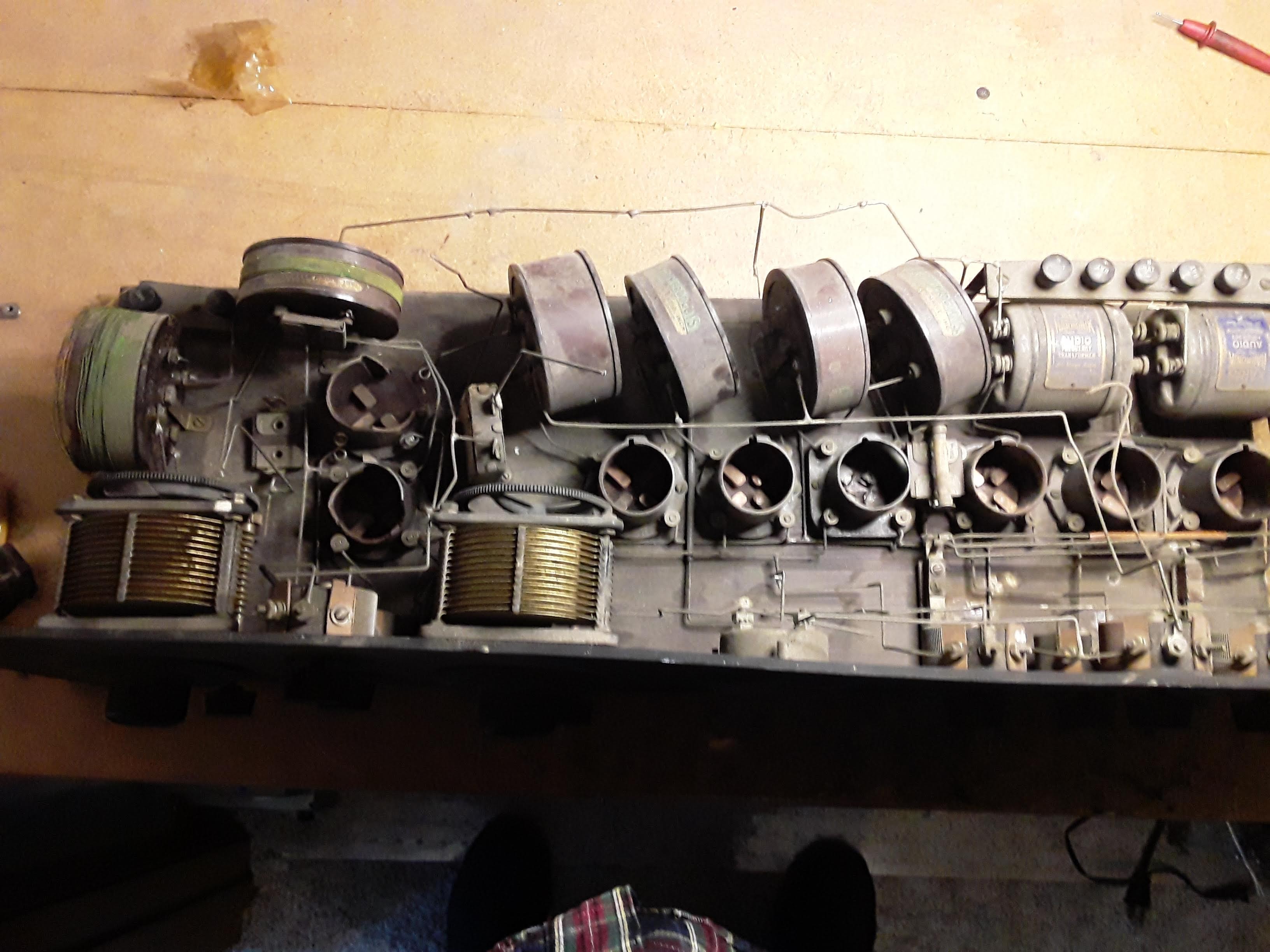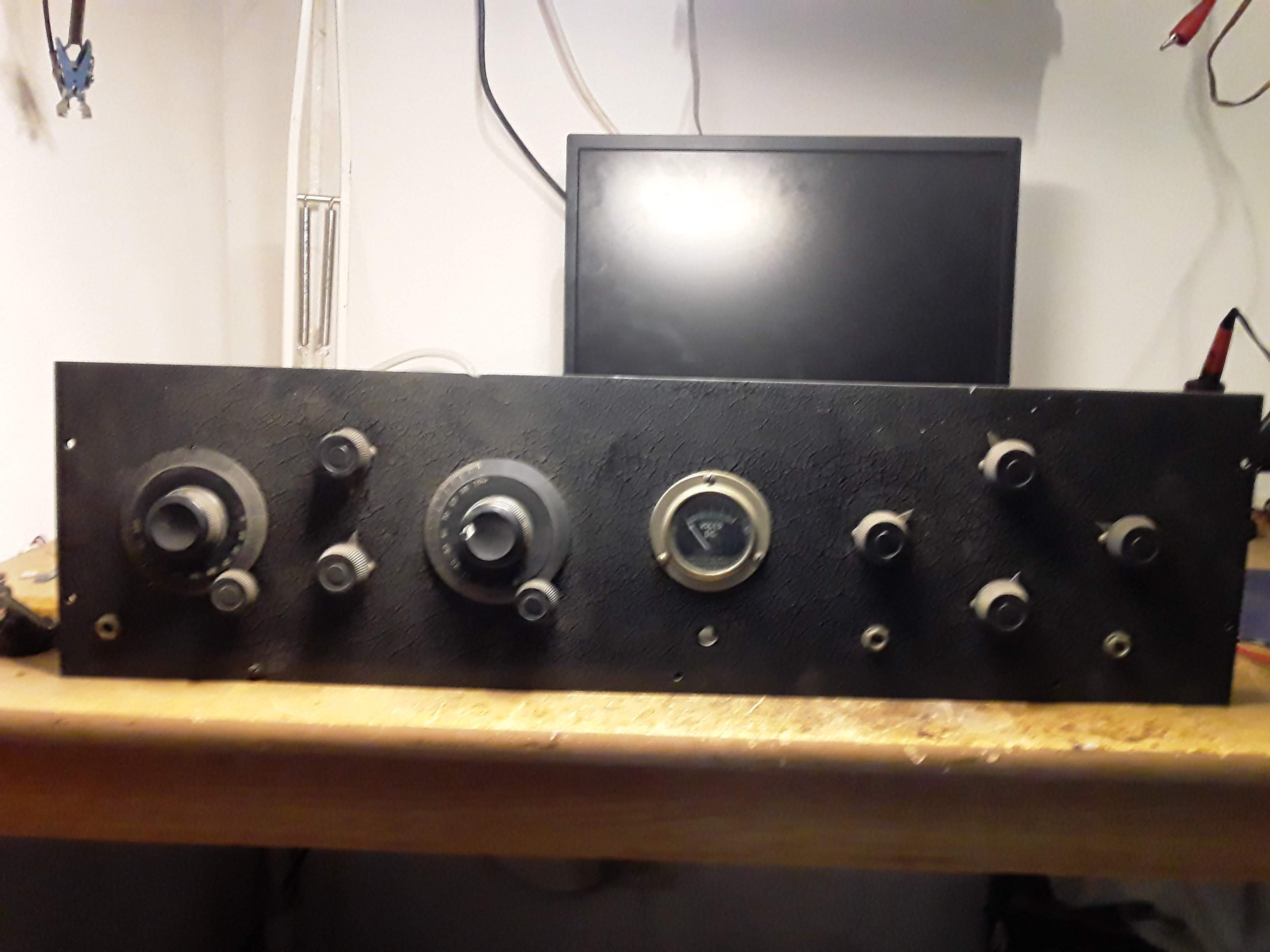04-19-2023, 10:08 PM
Any know what this radio is.


|
unknow radio id
04-19-2023, 10:08 PM
Any know what this radio is.
04-20-2023, 07:46 AM
It is a homemade 20's era superhetrodyne. It can be classified by "type" name by looking at the IF transformers, the audio transformers are Karas FWIK they, did not make the IF transformers. Uses all 201a type tubes and groups of "B" batteries from 22-1/2 to 135 and a 6 volt L/A battery usually 90 to 120 a/h.
Once the IF transformers are known, the schematic can be found via Google. There is a long running topic on ARF strictly for this type of radio... https://www.antiqueradios.com/forums/vie...rhetrodyne Pliny the younger “nihil novum nihil varium nihil quod non semel spectasse sufficiat”
04-20-2023, 07:59 PM
thanks
04-21-2023, 05:22 AM
Thanks for the link, Chas. Very interesting thread about home-made superheterodynes. I am very interested in this.
Old Tube Radio Online Museum / Музей ретро радіо https://www.youtube.com/user/RadioSvit?d...lymer=true Sincerely Peter З повагою Петро
04-21-2023, 10:02 AM
Peter,
Duane B, has done considerable research on these 20's supers. There is more than enough of Vinzer's super for a good restoration. Like many 20's home made construction quality varies widely. During a restoration build quality can be upgraded with an eye toward authenticity. A simple review shows two broken sockets and a missing jack, all relatively easy to find. Though the bus wiring is in shambles, mapping the circuit as best as possible then re-wiring will greatly improve performance (cold joints) and appearance. The radio can be operated from a socket power supply such as an ARBE-III, (I recommend) as a homemade supply will often not have the low impedance required and hum... There may be enough left of the IF decals to reproduce or someone known as a super collector may be able to image an IF to create replica decals. The radio may have provision for a loop, often this is a center-tapped loop. A high impedance horn or cone speaker. The cone will take advantage of the "higher" fidelity of Karas transformers. Something the builder seems to have considered important. What can be expected is the radio will have "two-spot" tuning from the use of independent tuning condensers and no provision for tracking. GL Chas Pliny the younger “nihil novum nihil varium nihil quod non semel spectasse sufficiat”
04-21-2023, 02:46 PM
what is missing on the front is the on off switch.
the if transformer's are victory products /victoreen radio inc. cleveland, ohio
04-21-2023, 03:55 PM
Looking at the front panel me thinks same size as rack mount used in old telephone exchange!
04-21-2023, 08:43 PM
Great its a Victoreen!
https://www.russoldradios.com/blog/super...-victoreen. http://www.duanesradios.info/html/victor...odyne.html Panels came in standard sizes for radio construction. Chas Pliny the younger “nihil novum nihil varium nihil quod non semel spectasse sufficiat”
04-24-2023, 10:48 PM
My radio doesn't match any of prints I found I have a capacitor across the top 2 terminals of ocs. coil and no capacitor on the plate of 2 detector.
04-24-2023, 10:58 PM
any know where to get a on/off switch.
04-25-2023, 08:10 AM
https://oldradioparts.net/controls.html
Hello Vinzer Here is Mark Oppats radio parts and he has volume and on/off switches . Sincerely Richard https://oldradioparts.net/controls.html]https://oldradioparts.net/controls.html
04-25-2023, 08:39 AM
Last First:
1920's era parts became obsolete by the early 30's. NOS parts are still "floating" around as well as parts salvaged from sets scrapped... Placing a want ad in the Phorum and in the ARF classifieds will benefit greatly. The name brand of the switch and its construction as possibly an image of it requires research on your part..... more in a bit... My impression is you want to restore the radio, must take a proper triage of all the components, do NOT disturb the wiring at any time until a near matching schematic can be found. You will need to know if the audio transformers are good taking resistance measurements with an analog ohmmeter must be done to access. Do not use a digital meter as most cannot deal with the very high reactance of these transformers upwards of 30 henrys and with Karas likely more. The more.. Look at the other jacks very likely there will be a brand name, at least take a couple pix to reveal design and construction of the jacks. All jack companies made switches, that brand is most likely been the switch that was cannibalized. An image of the switch could then be found by searching World Radio History (early radio). Kits of 20's radios often had "levels" of kit supplied, meaning some just IF/osc coils, others more components still others all components including a pre-drilled engraved panel, everything including bus wire and solder. Going only with the images offered you will need at least two tube sockets too. Mud tube sockets generally do not have a brand markings and can only be found by comparison. dsturz of ARF provides many 20's era parts removed from derelict sets, contact via ARF. IMHO the sockets are probably 'mud" composition but it is possible to break a quality Bakelite socket too. As far as the missing capacitor and errant wiring. Many early capacitor designs are hardware mountable and not soldered in. It could have been cannibalized. I sincerely hope that you will stay with OEM components and not result in crude makeshifts such as "stuffing". For the missing cap look at other caps in the radio, they are most likely Dublier 601 type. What ever the others are they can be found used., Yes, they will leak if they have gotten damp over time and possibly could be restored using a toaster oven at warmer heat. As for the value of the "missing" cap. it will become evident if it is missing and required for function or may not, in some designs where hook-up directly to a loop is involved. Savvy builders often modified circuits for their purposes, not all mods were successful. Publish the circuits you now have or point to their sources so I and others can review.. If I cannot provide enough data, post to the ARF superhetrodyne topic and go from there. I have but two super types form the 20's so hard evidence of function of others must come from other collectors. You will also need tubes so likely all '01a's and a 112 in the last audio.. If a power supply is used do not skimp on design function, I recommend an ARBE-III despite the cost as it is very flexible for other 20's radios and rugged, it is repairable when out of warranty. GL Chas Pliny the younger “nihil novum nihil varium nihil quod non semel spectasse sufficiat”
04-25-2023, 07:53 PM
I have no idea what the on / off switch looks like it was missing when I got the radio the power had a wire to keep it on all the time if's and audio transforms are good ant coil outer winding is bad and maby osc coil going rewind ant coil but it will not be the right color if I get it working I will try to get a orginal.
04-25-2023, 07:59 PM
the radio came with 12 new 01a. I think the on/off was a push pull what I seen a norther radio.
04-25-2023, 09:04 PM
Quote:I have no idea what the on/off switch looks like it was missing when I got the radio the power had a wire to keep it on all the time if's and audio transforms are good ant coil outer winding is bad and may be osc coil going rewind ant coil but it will not be the right color if I get it working I will try to get a original.The ON/OFF switch will likely be the same brand as the phone jacks on the panel. Look at those for a brand name. Could be Freshman, Yaxley, BMS (Brooklyn Metal Stamping) Freed-Eiseman, etc. Then go to WRH to find a picture of the switch. If there is a shadow of a name plate in the panel, then it was a rotary (1/4 turn) switch. The wires coming to the switch will determine the frame type and position. Some switch frames were offset. I could also be a Cutler-Hammer that has an ovoid body and two screw terminals for connection. Do you know the gauge and turns for the antenna coil and what color do you suspect the antenna coil was? As for the oscillator coil, the direction, wire size as well as turns are very important if the full tuning range of the set will not be realized or it may not oscillate at all. So, turns and wire size are very important. If it was DCC it must remain so as the cotton covering spaces the windings. I do not expect it to tune much higher than 1300khz. It will also have two spot tuning, tune the same station on two locations of the dial. Chas Pliny the younger “nihil novum nihil varium nihil quod non semel spectasse sufficiat”
« Next Oldest | Next Newest »
Users browsing this thread: 1 Guest(s) |
|

|